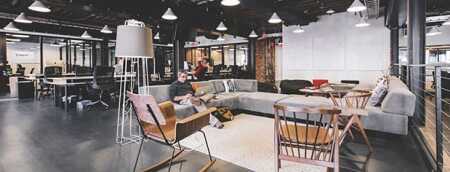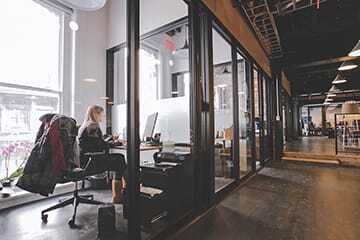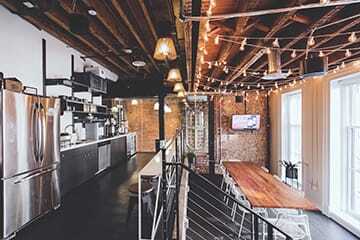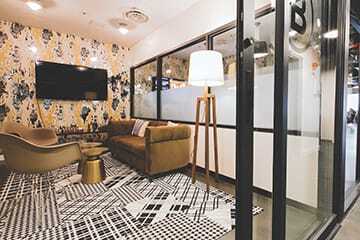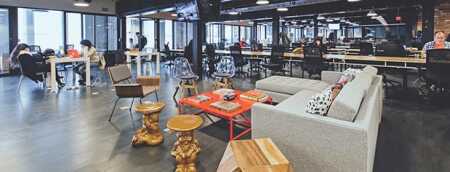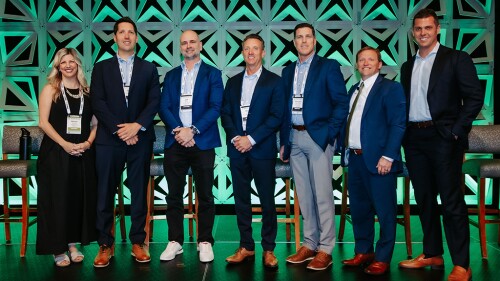In Washington D.C.’s Chinatown neighborhood, a stately 133-year-old building that once housed a furniture store has been transformed into what may be the workspace of the future.
Upstairs, within a sprawling expanse of exposed brick capped by a high ceiling of exposed steel I-beams, sunlight floods through windows as rows of knowledge workers sit at long tables and stare intently into their computer screens; others labor at standing desks in glass-enclosed offices along the periphery or hold phone conferences in special booths tucked into hallways. Others are chatting in a kitchen alcove next to a supply of gourmet coffee and a cooler filled with cucumber-flavored filtered water. Around the reception area, whimsical furnishings—including golden lawn-gnome end tables and a Rock ’Em Sock ’Em Robots game—further signify the departure from corporate staidness.
But the salient feature of this office space—one of more than two dozen buildings in U.S. cities operated by the New York City–based company WeWork—is that all its workers do not have the same employer. Instead, this is a coworking environment, where individual tech entrepreneurs may be sitting alongside professionals such as attorneys and interior designers. The clientele runs the gamut from Crowdskout, a tech startup that is building a data and analytics platform to help publishers and marketers connect with their audiences, to workers for the fashion retail website Gilt. It even includes a traveling magician, Max Major, who uses the space to manage his business when in town.
For as little as $325 a month for table space to $3,600 for a six-person enclosed office, WeWork seems to cater particularly—though not exclusively—to young members of the millennial generation, who have grown accustomed to starting and running their own businesses on a shoestring.
“There’s been this generation of people who came out of the Ivies and elite schools during the recession when there weren’t any jobs,” says WeWork city lead Carl Pierre, age 25. “So they stayed at home with their parents and started companies on their living room couches. But now they’ve grown and they need to move their companies into real spaces, but they don’t have the capital or access for conventional commercial space.” Or they may simply prefer a working environment that, in addition to providing an internet connection and printing services, offers both a meditation room and free beer on tap.
Welcome to the world of coworking, a rapidly growing phenomenon that seems likely to have a significant impact on both the economy and development of urban and suburban cores where such spaces tend to be located. Since its beginnings in the mid-2000s in San Francisco, coworking has spread to the point where there are probably more than 1,000 coworking spaces across the United States, according to Steve King of Emergent Research, a Lafayette, California–based analytical firm, who was one of the first to study the nascent trend. Deskwanted.com, a website devoted to coworking, reports it has outposts as far away as Japan and Brazil. “It’s grown at a faster pace than anyone had anticipated,” King says. “It’s become hard to count them.”
Whereas the earliest coworking spaces were barely a step up from a table at Starbucks, larger providers have emerged to offer more sophisticated infrastructure and amenities, from event space and child care to smartphone apps that notify clients that their appointments have arrived. Coworking also has diversified, with a dizzying array of options and hybrids, ranging from spaces such as San Diego’s Hera Hub, which serves women entrepreneurs, to buildings that cater to specific industries or to nonprofits and environment-focused businesses. And they have grown beyond office work to include “maker spaces,” where tenants may share tools, industrial machines, or even commercial kitchens.
“The spaces all have their own unique culture and vibe,” King notes. “And they attract people who fit.”
But they all provide at least a few of the same benefits. Coworking spaces, which are usually based in renovated former industrial or retail buildings, have the potential to stimulate local economic growth by providing employment and by serving as anchors for development near the buildings. And because coworking providers tend to pick locations in or close to mixed-use neighborhoods that are accessible by walking, biking, or public transit, the concept is a good fit with the movement for revitalizing communities.
A Flexible Infrastructure
Most credit the concept of coworking to a software coder named Brad Neuberg. In 2005, he put up $300 a month to rent a space from a feminist collective in San Francisco’s Mission District, provided card tables to serve as desks, and then put a notice on Craigslist to invite others to work alongside him. His goal, as he later recalled in a blog post, was to find “the freedom and independence of working for myself along with the structure and community of working with others.” To his chagrin, no one showed up for the first month. But eventually other entrepreneurs trickled in, and within a few years a handful of other coworking spaces existed with names such as Citizen Space and Sandbox Suites. They mostly catered to what a 2008 San Francisco Chronicle article called “laptop nomads”—freelance graphic designers, writers, artists, and tech entrepreneurs who had grown weary of searching for seats in coffee shops with free wireless internet access.
The economic downturn of the late 2000s, which accelerated the shift toward a free-agent economy, gave coworking a shot of adrenaline. Among those who decided to capitalize on the nascent trend was Liz Elam, a former sales executive for Dell, who founded Austin-based Link Coworking—in part, she says, because “I wanted to be in a space like this instead of in the basement with my cat.”
These days, coworking’s explosive growth has being driven not by whimsy, Elam says, but by entrepreneurs who need to be mobile and independent and who want to choose where they work. The phenomenon has mushroomed to the point where well-established tech hubs such as Austin may have 40 to 50 such buildings, King says.
At the same time, coworking has fragmented into subsectors. At the top, outfits such as WeWork, which builds large urban office spaces with high-end amenities, and Santa Cruz, California–based NextSpace, which has expanded to cities such as Chicago and Dallas, have become dominant. But plenty of opportunity remains for smaller operations such as Cove, a Washington, D.C.–based coworking company that rents to clients by the hour instead of month and builds its spaces in converted townhouses rather than old office or industrial buildings in order to give them a casual, quirky feel, cofounder Adam Segal says.
“We’re promoting ourselves as an alternative to the coffee shop or your living room rather than as a dedicated office solution,” Segal explains. “You can work here for the price of a latte for a couple of hours, and we’ll give you the coffee.”
But beneath the ambience, Cove’s decor is optimized for productivity, Segal says. His spaces feature seven different kinds of seating, ranging from couches to standing desks, to allow workers a change of pace. The spaces also have commercial-grade printers and internet access from multiple providers, giving clients options if one provider experiences an outage.
Locating and Designing a Space
Most providers say location is a critical aspect of a successful coworking space, even more so than it is for traditional corporate office developments. WeWork, which employs its own in-house real estate team, focuses on finding buildings that, in addition to being architecturally distinctive, are close to transit routes and modestly priced housing. “If you’re a small businessperson in Washington, you’ll be living in Petworth or Columbia Heights,” says WeWork’s Pierre. “So we want to be accessible to those neighborhoods.” The company also does extensive market research, which includes sending interviewers to local bars and other hangouts to talk to residents about a neighborhood’s pluses and minuses.
Whereas urban cores seem like a natural environment for coworking, other providers have been successful in suburban locations. When sisters Tammy Magney and Peggy Stefan decided to open a coworking space, the Commons, they settled on Excelsior, Minnesota, about a 20-minute drive from Minneapolis. “It’s a really interesting small town, with restaurants that people pull their boats up to and local mom-and-pop retail; there aren’t any chains or franchises,” Stefan says.
That might not be the most attractive neighborhood for millennial laptop nomads, but it is a prime location for what Magney and Stefan saw as an underserved market—middle-aged professionals and regional executives for big companies who needed a place to work when they were not on the road. “We have a Realtor, a medical insurance broker, a general contractor, four architects, and a person who does background checks,” Stefan says.
Magney, an architect who spent 30 years designing schools, supervised the conversion of what had been a bicycle repair workshop. Rather than put up new walls or barriers, she painted the existing walls different colors and arranged the furniture to create zones within the space, plus installed a white-noise system to muffle sound. For a common area where workers could interact, she created a library space filled with reference books as well as samples of products that manufacturers provided in hopes that the space’s users might purchase them. She managed to complete the project for the modest cost of $26 per square foot ($280 per sq m).
In Austin, Elam, who operates two coworking spaces in addition to consulting for other providers, has a different formula that is tailored to sun-drenched, car-dependent Texas. She looks for first-floor locations on streets bookended by major thoroughfares and providing ample parking and covered outdoor seating. “But I always look for proximity to retail and restaurants, close to where people live,” she adds. “I like being out on the edge rather than at the city core.”
But coworking spaces also have the potential to be anchors that attract development nearby—restaurants, coffee shops, and retailers that set up shop to cater to the infusion of office workers. Elam, who developed one of her coworking spaces in a shopping center, notes, “When I signed my lease, the center was at 20 percent occupancy. Now it’s at 90 percent. I’d say that we helped that.” Similarly, Pierre expects WeWork’s new location in the old Wonder Bread factory in Washington’s Shaw neighborhood to provide economic stimulus there. “We’ll have 550 entrepreneurs working in Shaw,” he says. “It’s going to drive more businesses to stay open during the day and get people to reassess the neighborhood. When clients come by, they’re going to see it. I think it’s one of the coolest neighborhoods—the kind of place where you would find someone like me on a Friday night.”
Coworking is becoming such an attractive option that big companies such as American Express are now placing some of their small teams off site in coworking spaces in order to develop contacts and potential clients and gather business intelligence. Other companies, King notes, are redesigning their offices to feature open spaces that foster more interaction, in the fashion of coworking.
But everyone seems to agree that coworking is a trend on the rise. Elam cites a 2013 study by Intuit that predicts that by 2020 more than 40 percent of the U.S. workforce—about 60 million people—will be freelancers, contractors, or temp workers. “Coworking really dovetails with that,” she says. “It’s got nowhere to go but up.”
Patrick J. Kiger is a Washington, D.C.–area journalist, blogger, and author.

